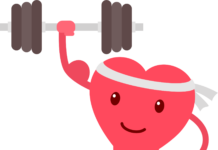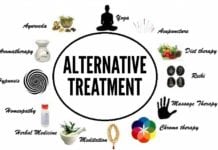One important element of most people’s health, diseases, injuries, fitness and fat loss programs that usually gets overlooked is goal setting. Most people who have successful exercise regimens have taken the time to create a clear blueprint for themselves and their future.
Even if they started the process of goal setting and personal strategic planning with a little skepticism, every one of them has become a true believer. Every one of them has accomplished far more than they ever believed possible, and they ascribe their success to the deliberate process of developing a detailed, written road map to get them to where they wanted to go.
The Definition of Happiness
Happiness has been defined as, “The progressive achievement of a worthy ideal, or goal.” When you are working progressively, step-by-step, toward something that is important to you, you generate within yourself a continuous feeling of success and achievement. You feel more positive and motivated. You feel more in control of your own life. You feel happier and more fulfilled. You feel like a winner, and you soon develop the psychological momentum that enables you to overcome obstacles and plow through adversity as you move toward achieving the goals that are most important to you.

Are You Fuzzy or Clear?
Successful people are successful because they are very clear about their values. Unsuccessful people are fuzzy or unsure. Complete failures have no real values at all.
Determine Your Values – What’s Important to You?
Personal strategic planning begins with your determining what it is you believe in and stand for–your values. Your values lie at the very core of everything you are as a human being. Your values are the unifying principles and core beliefs of your personality and your character. The virtues and qualities that you stand for are what constitute the person you have become from the beginning of your life to this moment. Your values, virtues and inner beliefs are the axle around which the wheel of your life turns.
All improvement in your life begins with you clarifying your true values, and then committing yourself to live consistent with them. The first thing to keep in mind is that your goal must be congruent with your belief system, or else success will likely linger beyond your reach. I think (or at least hope) we can agree that being healthy is a wonderful thing. Therefore, if being healthy is in your belief system, you are congruent with the goal of mastering the dietary recommendations and working out according to plan!
Your mind contains a cybernetic goal-seeking mechanism. Once you have programmed a thought or desire into your subconscious mind, your subconscious and your superconscious mind take on a power of their own that seems to drive and steer you to attainment of your goal, whatever it is.
Unfortunately, less than 3 percent of adults have clear written goals with plans on how to achieve them. This article will help you be one of those 3 percent.

Step 1: Develop desire for getting healthy again
A desire is completely personal and comes from within. Our actions are usually based on fear or desire. If you are trying to implement the dietary recommendations because you are fearful that you will stay sick or injured to never achieve that goal you would like, you are most likely going to fail.
Fear is a powerful force, but not one that spurs you toward greatness. Desire, though, is a burning that comes from within and has the power to change your very nature and core.
Step 2: Believe you CAN be successful
If there is any doubt in your mind that you may not be able to achieve something, you don’t give it your all. In fact, you may very well just set it aside. In order to fully achieve anything, you must believe it is possible at a cellular level. Make your goals obtainable, and set short-term goals that slowly but surely lead up to your long-term goal.
Step 3: You MUST write it down
Having a goal of exercising optimally or weighing a certain amount is not a goal if it is not in writing. Until you put it in writing, it is a fantasy. Once your goal is in writing, it is concrete. I would encourage you to write out your goal in two ways.
The first way is to use a lot of detail. Be specific on what your life will be like when you have met this goal. Let your imagination run wild. If your goal is eating optimally, write in detail what your meals will look like and what you will be able to do with all the energy you now have. Then, put this in an envelope to read when you need encouragement and motivation.
The second way I encourage writing it down is in one sentence that captures what that goal is. For instance, you may write “I choose only foods that add life and vitality to my organs and cells and hydrate myself with clean, pure water.” Take this sentence and write it on several post-it notes. Place them in your car, at your office, on your bathroom mirror and one by your bed. Before retiring for the night, read your sentence a few times and then spend 1-2 minutes visualizing what that is like.
Step 4: Make a list of all the ways that you will benefit from achieving your goal, and get EMOTIONAL
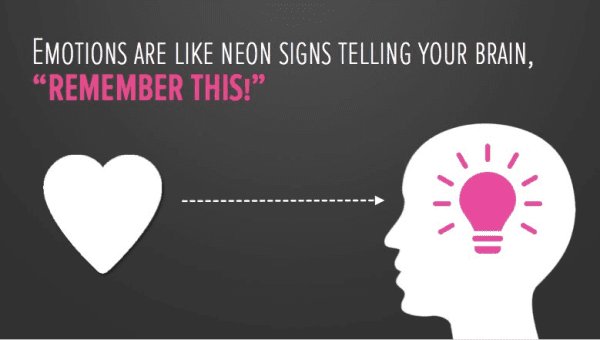
This is similar to what was recommended above. The reasons why you set your goal are the forces that will move you in the direction of the goal. The reasons may include having more energy, looking better, feeling great, or fitting into a dress. Reviewing this on a regular basis will assist in keeping you motivated.
Remember to use the word “I” with each goal, and write it in the present tense. Your subconscious mind responds only to commands that are personal, positive and in the present tense. Plugging in your emotional reasons for wanting to optimize your fitness and fat loss is crucial. It is the “why” to the “what.” It does not matter what they are. Just make sure that they are real for you. Pick the top two or three emotional reasons why you must become healthier, leaner, stronger, and more energetic, and focus on those. An important tip in developing goals is to use the word “I” with each goal and write it in the present tense. Your subconscious mind responds only to commands that are personal, positive and in the present tense.
To give you some ideas, here’s a list of 15 ways exercise can improve your health:
- Improve your brainpower
- Lower your blood pressure
- Fight off a cold
- Manage arthritis
- Lower your risk of heart disease
- Cure insomnia
- Fight depression
- Lower your risk of diabetes and reverse pre-diabetes
- Build strong bones
- Lose weight
- Reduce your risk of cancer
- Boost your IQ and think better
- Relieve chronic knee pain
- Increase your energy levels
- Slow down your aging process
You can use the exercise benefits above as a help to create personal reasons for you that are LOADED with emotion. Remember that unless you have emotion attached to your reasons, the likelihood that you will succeed is radically reduced.
Step 5: Analyze your position, your starting point
This will provide a starting point, a baseline, to measure your progress. If your goal is to be pain free in your lower back or to lose weight to have less stress in your back. So weigh yourself and write down where you are. If your goal is to lower your cholesterol or blood pressure, have your cholesterol or blood pressure measured and write down where you are.
Step 6: Set a deadline
If your goal is to obtain a certain weight, blood pressure, or cholesterol, set a deadline. These are tangible goals. Setting a deadline programs it into the cells to achieve that goal by a certain time, if not sooner.
However, if your goal is intangible, such as optimizing health, do not set a deadline. If you set a deadline on an intangible goal, such as “optimizing health”, the date you set will be the first date your cells are programmed to actually start demonstrating that quality. If you do set a deadline and fail to reach it, set another deadline.
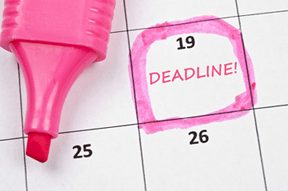
Step 7: Make a list of obstacles that stand between you and the accomplishment of your goal
After listing all the possible obstacles that you can think of, re-list them in order of the difficulty to overcome them. The obstacles you list may be internal or external.
An internal obstacle would be a belief that you have about yourself, or an attitude. “This stretching exercise is too difficult” or “I don’t have time to prepare healthy foods to help my injuries recover faster” are examples. An external obstacle is something outside of yourself, such as a spouse who brings you chocolate, or friends who like to eat out at restaurants.
Step 8: Identify the additional information you will need to achieve your goal.
There are multiple resources available on many subjects. If there is an area you are pursuing, research it and empower yourself with all of the information you can. Successful people are those who obtain and have information.
Arm yourself with knowledge on why you want to be injury free. One example, is know why weighing too much or having excess body fat is unhealthy if you have back issues. Setting a goal and going after it without knowing why you are going after it is a sure-fire way of stopping short of your goal.
Step 9: Make a list of all the people whose help and cooperation you will require
This list may include family, friends, co-workers, your doctor and whomever else you deem appropriate. You are going to require the help and encouragement of others in achieving any goal. Although you want to be careful in selecting only those who you know will support and encourage you in the fullest.
Unfortunately, there are people out there who seem to sabotage others, especially when it comes to trying to achieve a better health or life. Educate the people you select on the reasons you are working toward your goal. If you present it well, they may even decide to join you and then you will be really supported and held accountable!
Step 10: Make a plan
Write out in detail the entire plan: what you want, when you want it, why you want it, and from where you are starting. List the obstacles to overcome, the information you will need and the people you need to help you. Use steps 1-9 to help with this.
Step 11: Use visualization
Visualization is a powerful tool. What you see is what you get. And what you eat provides the energy that enables you to become what you want. Picture yourself do some form of stretching or exercise that you are required to do at home that your exercise specialist prescribed to you.
Visualize yourself participating in activities that also add life and provide energy. Picture how good you will feel when implementing it. Imagine life with health. Take time each day for this. As recommended in step 3, do this at night before retiring while reading the sentence you created.
I also highly suggest that you cut a picture of yourself before your injuries or somebody that inspires you so you can print one off the computer. It is important for you to see this often throughout the day. I did this 15 years ago, and within 2 years I rehabilitated my back from a severe car accident. It works.
Step 12: Make the decision in advance that you will never, ever, give up
As they said in Apollo 13: “Failure is not an option.” A lot of the patients I work with at times become frustrated, but they do not give up. I have become frustrated at times also with eating optimally and making healthy choices, but I have NEVER given up.
When you realize how important food, resting, emotional well-being, support from others, rehabilitation, and exercising are to your core being, you will want to persevere. Surround yourself with those who are choosing wisely and who care enough about you to hold you accountable. We all have days, or weeks, where we slip. The important thing is that you realize this, admit it, and get back with the program.
Be VERY Clear About Your Goals
Clarity accounts for probably 80 percent of success and happiness. Lack of clarity is probably more responsible for frustration and underachievement than any other single factor. You could say that the three keys to achieving your goals are “Clarity, Clarity, Clarity.” Your success in life will be largely determined by how clear you are about what it is you really, really want.
The more you write and rewrite your goals and the more you think about them, the clearer they will become about them. The clearer you are about what you want, the more likely you are to do more and more of the things that are consistent with achieving them. Meanwhile, you will do fewer and fewer of the things that don’t help to get the things you really want.
The Seven Step Process to Achieve Goals Faster and Easier
First, decide exactly what you want to achieve.
Second, write it down CLEARLY and in as much detail as you can.
Third, set a specific deadline. If it is a large goal, break it down into sub deadlines and write them down in order.
Fourth, make a list of everything you can think of that you are going to have to do to achieve your goal. As you think of new items, add them to your list.
Fifth, organize the items on your list into a plan by placing them in the proper sequence and priority.
Sixth, take action immediately on the most important thing you can do in your plan. This is VERY important.
Seventh, do something every day that moves you toward to attainment of one or more of your important health goals.
Remember that fewer than 3 percent of adults have written goals and plans that they work on every single day. When you sit down and write our your goals, you move yourself in to the top 3 percent of people in our society. And you will soon start to get the same type of results that they do.
Study and review your goals EVERY DAY to be sure that they are still your most important health goals. You will find yourself deleting goals that are no longer as important as you once thought.
Whatever your goals are, plan them out thoroughly, on paper, and work on them every single day. This is the key to peak performance and maximum achievement.
I truly hope that the steps provided assist you in your journey toward health and in creating the life you choose. Setting goals is necessary if you are going to direct your life. May you be blessed with wisdom and love as you go about setting goals and achieving them!
Commitment Sheet
Here is another example of a goal setting tool that we use with our clients. It is called a commitment sheet. This is a commitment that you make to yourself, that ties everything together.
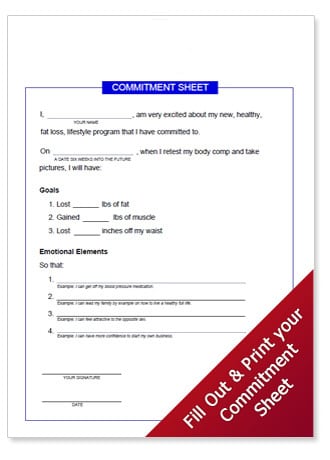
As you can see, the commitment sheet is written in the present tense, as if you’ve already accomplished your goals.
Your homework now is to read the commitment sheet out loud, with a positive tone in your voice, three times, right before bed. Also read your commitment sheet right upon waking in the morning. There is power in the spoken word. So stand up tall, with good posture, and say it like you mean it.
At these times of the day you are in an alpha brain state. This is a prime time for you to be more susceptible to auto suggestion or self hypnosis. Your mind will repeatedly review what you were
Program Your “Faith Muscle”
What you are doing when you go through all these steps and visualizations is working on your “faith muscle”, so that you can optimize your health, injuries, and wellness goals. Therefore allowing you to peak in all the areas of your life, at any age.
This is a great mental and emotional exercise, because what I have found for myself, my trainers, and my clients, is that once you believe something, with a sense of certainty deep down in your core, it will almost always become true. That is what this commitment sheet can do for you. It is very powerful. I have seen well over 100 personal clients radically be disease free, injury free, lose weight, improve their lifestyle, and their lives by using this goal setting/visualization tool. Remember, a healthy lifestyle is the only true fountain of youth that exists. And yes, you DO have the power to change!!





